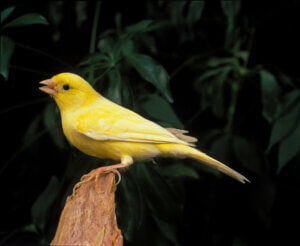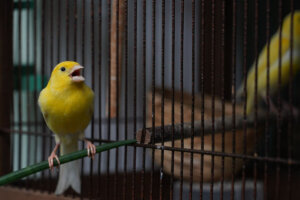The Song of the Canary and the Reason Behind It


Written and verified by the biologist Samuel Sanchez
The canaries (Serinus canaria domestica) are the most widespread group of domestic birds raised as pets in the whole world. They compete for first place with only one species: the common parakeet (Melopsittacus undulatus). In this article, we’ll be looking at the song of the canary.
These charismatic and energetic birds have accompanied humans since the 17th century. Back then, they were exported from the Canary Islands and brought to Europe by Spanish sailors. Their prices were prohibitive, and their presence in any court was a symbol of wealth and power.
Many keepers decide on this species when acquiring a bird because its characteristic song makes any home full of joy. So, do you know why canaries sing? You’ll find the answer in this article.
The song of the canary
First of all, we need to know the main characteristics that define the song of the canary. This bird emits chirping sounds — acute and prolonged, with rapid upward and downward changes — with the beak closed, sporting a very peculiar “swollen” looking throat.
On the other hand, canaries open their beaks to emit certain sounds with a “metallic” tone. The tone may vary in stridency according to each specimen. This is the most audible portion of the song and one which we’re all familiar with.
The sophistication of tonalities of this small animal has triggered the appearance of various societies that organize singing contests with very specific rules. Depending on the type of tonality, we can distinguish different types of canaries:
Choppers: they sing in a strident way, with broken tones and a very open beak. They’re normally selected for their physical characteristics —size, color and bearing— rather than for their sound attributes.
Rollers: they produce softer tones characterized by the presence of gentler chirping, as they don’t usually open their beaks much when singing. They’re singing canaries in a very strict sense. Their tones are very pleasant to the ear, hence they usually appear in contests and competitions.
Warblers: they make diverse combinations of sounds during their singing.
As we’ve been able to see, the world of canary singing is much more sophisticated than one might believe at first, but what’s the evolutionary meaning of such strident vocalizations?

What is the reason behind their singing?
First of all, it’s necessary to note that female canaries also emit vocalizations, although they aren’t singers strictly speaking. They only produce choppy chirps, never in a sustained manner or with changes in their verses.
Therefore, we can affirm that only males emit the song we know so well. From an evolutionary point of view, this is a sexually dimorphic behavior, given that only one of the two sexes displays the described trait.
Thus, we can imagine why male canaries sing: to look for females and to define their territories. This theory makes perfect sense in practice as many males drastically decrease the frequency of singing when a female enters their cage.
Furthermore, experiments have shown that the administration of testosterone —essential for the development of male traits— to female canaries causes them to sing just as males would.
This happens because the cerebral nuclei controlling singing grow up to 90% in females due to the administration of the hormone. These data provide more evidence for the theory that vocalizations have a reproductive function, as testosterone encodes the cerebral singing capacity of the canary according to its sex.
95 % of female canaries don’t emit almost any type of sound. Those that do, base their vocalizations on choppy chirps.

The song of the canary: a question of hormones
Therefore, going back to the question of why canaries sing, we can give a clear answer. Sexual hormones allow the development of various cerebral nuclei, which make the emission of vocalizations possible in order to attract females.
Even so, this doesn’t mean that all male canaries sing continuously. These birds stop emitting vocalizations during the molting season, due to stress, parasitic diseases, and many other reasons. Singing is one more characteristic of this beautiful animal, but certainly not the only one.
The canaries (Serinus canaria domestica) are the most widespread group of domestic birds raised as pets in the whole world. They compete for first place with only one species: the common parakeet (Melopsittacus undulatus). In this article, we’ll be looking at the song of the canary.
These charismatic and energetic birds have accompanied humans since the 17th century. Back then, they were exported from the Canary Islands and brought to Europe by Spanish sailors. Their prices were prohibitive, and their presence in any court was a symbol of wealth and power.
Many keepers decide on this species when acquiring a bird because its characteristic song makes any home full of joy. So, do you know why canaries sing? You’ll find the answer in this article.
The song of the canary
First of all, we need to know the main characteristics that define the song of the canary. This bird emits chirping sounds — acute and prolonged, with rapid upward and downward changes — with the beak closed, sporting a very peculiar “swollen” looking throat.
On the other hand, canaries open their beaks to emit certain sounds with a “metallic” tone. The tone may vary in stridency according to each specimen. This is the most audible portion of the song and one which we’re all familiar with.
The sophistication of tonalities of this small animal has triggered the appearance of various societies that organize singing contests with very specific rules. Depending on the type of tonality, we can distinguish different types of canaries:
Choppers: they sing in a strident way, with broken tones and a very open beak. They’re normally selected for their physical characteristics —size, color and bearing— rather than for their sound attributes.
Rollers: they produce softer tones characterized by the presence of gentler chirping, as they don’t usually open their beaks much when singing. They’re singing canaries in a very strict sense. Their tones are very pleasant to the ear, hence they usually appear in contests and competitions.
Warblers: they make diverse combinations of sounds during their singing.
As we’ve been able to see, the world of canary singing is much more sophisticated than one might believe at first, but what’s the evolutionary meaning of such strident vocalizations?

What is the reason behind their singing?
First of all, it’s necessary to note that female canaries also emit vocalizations, although they aren’t singers strictly speaking. They only produce choppy chirps, never in a sustained manner or with changes in their verses.
Therefore, we can affirm that only males emit the song we know so well. From an evolutionary point of view, this is a sexually dimorphic behavior, given that only one of the two sexes displays the described trait.
Thus, we can imagine why male canaries sing: to look for females and to define their territories. This theory makes perfect sense in practice as many males drastically decrease the frequency of singing when a female enters their cage.
Furthermore, experiments have shown that the administration of testosterone —essential for the development of male traits— to female canaries causes them to sing just as males would.
This happens because the cerebral nuclei controlling singing grow up to 90% in females due to the administration of the hormone. These data provide more evidence for the theory that vocalizations have a reproductive function, as testosterone encodes the cerebral singing capacity of the canary according to its sex.
95 % of female canaries don’t emit almost any type of sound. Those that do, base their vocalizations on choppy chirps.

The song of the canary: a question of hormones
Therefore, going back to the question of why canaries sing, we can give a clear answer. Sexual hormones allow the development of various cerebral nuclei, which make the emission of vocalizations possible in order to attract females.
Even so, this doesn’t mean that all male canaries sing continuously. These birds stop emitting vocalizations during the molting season, due to stress, parasitic diseases, and many other reasons. Singing is one more characteristic of this beautiful animal, but certainly not the only one.
All cited sources were thoroughly reviewed by our team to ensure their quality, reliability, currency, and validity. The bibliography of this article was considered reliable and of academic or scientific accuracy.
- Nottebohm, F. (1980). Testosterone triggers growth of brain vocal control nuclei in adult female canaries. Brain research, 189(2), 429-436.
This text is provided for informational purposes only and does not replace consultation with a professional. If in doubt, consult your specialist.








